|
|
Sitemap | Contact us |
|
 |
 |
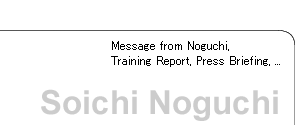 |
|
|
Astronaut Noguchi's Training Report, #8
|
||||||||||||||||||||||||||
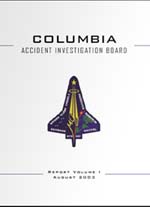 |
| CAIB report |
On February 1, 2003, seven astronauts were lost in the Space Shuttle Columbia accident. Immediately after the disaster, the Columbia Accident Investigation Board (CAIB) was formed to determine the cause of the accident. It was chaired by Admiral Harold Gehman and consisted of thirteen members. Over 120 people and about 400 NASA engineers were involved in the research. More than 25,000 people got together to search and collect the Columbia debris. We of the STS-114 crew also joined the party to search for debris of the vehicle in the forest (for details of the recovery activities, please refer to Activity Report #6). The final CAIB report was issued nearly seven months after the disaster on August 26, 2003, through the dedicated efforts of the CAIB members and numerous other people.
According to the CAIB report, the cause of the accident was a breach made by a piece of foam that hit the vehicle on its left wing. At 81.7 seconds after the launch, the "bipod ramp," an attachment between the orbiter and the External Tank, fell off and struck the leading edge of the left wing and made a breach in its Reinforced Carbon-Carbon (RCC) panel. In order to protect the Shuttle from extremely high temperatures (up to 1,500 degrees Celsius) during reentry, it is covered by 20,000 ceramic tiles. The edges on both sides are covered with 22 Reinforced Carbon-Caron (RCC) panels. When Columbia made its reentry, the hot air streamed into the vehicle through the breach and burned the aluminum off on the left wing. The Shuttle then lost control, which resulted in a midair breakup.
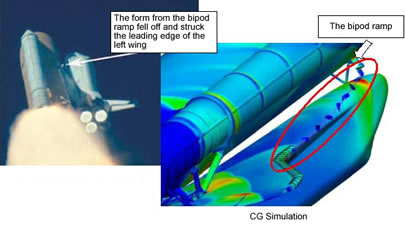 |
In addition to determining the physical cause of the accident, CAIB analyzed a vast range of issues including NASA's cultural problems and the background of the Space Shuttle Program. The final report is made up of 250 pages including 29 recommendations, of which 15 must be met before return to flight.
 |
| Recovered debris of the Columbia (Kennedy Space Center) |
I read the report as a member of the STS-114 crew and thought it was a fair, well-balanced report even though it had the severe tone that every accident report has. It elaborated both on engineering and organizational problems to develop guidelines for a safe return to flight and beyond.
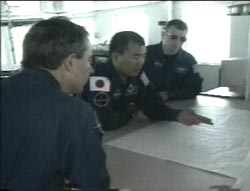 |
| Checking the recovery area |
NASA's Response to the Report
Now that the CAIB has analyzed the accident and pointed out the source of the problems, it's NASA's turn. It is time for NASA to make a plan and implement it to solve them. On September 8, two weeks after the release of the CAIB report, NASA issued NASA's Implementation Plan for Return to Flight and Beyond. The report was organized in the same order that points appeared in the CAIB report. In addition, to make NASA a safety-first agency, it also contained issues that are not included in the recommendations.
It is not, however, a finished document. Rather, it's a living document that will be revised occasionally to add additional analysis or to report progress made towards resolution. NASA had been coping with some of the problems provided in the preliminary recommendation before the final CAIB report was issued. However, there are other cultural problems that need further consideration or more time to be implemented.
We have sought any training we could conduct prior to the release of the CAIB report. I'd like to show you some of the training we have been working on.
 Thermal Protection System Repair
Thermal Protection System Repair
We need to establish an on-orbit method of repairing the Thermal Protection System and RCC panel before returning to flight. I participate in developing the techniques and tools suitable for each damage level.
Below is a picture showing the Neutral Buoyancy Laboratory (NBL), a huge pool where astronauts receive EVA training. As you know, when you are in water, you feel like you are floating. The NBL is well-suited to create an environment similar to that of space.
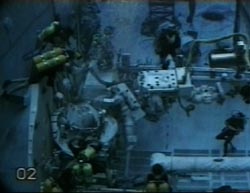 |
 |
| Tile repair training in NBL | |
 |
| KC-135 |
Let me give you another example of our activity. By free-falling the KC-135 aircraft (we call it parabolic flight), you can create a weightless environment. We did the tile repair training using those aeronautics. Each fall provides about 25 seconds of low-gravity conditions, and we repeat it several tens of times in a single training session.
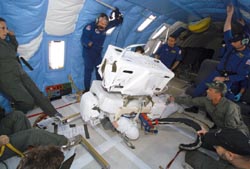 |
| Astronaut Noguchi receiving tile repair training |
We are bound by gravity when we are on the Earth but not while we are in space. Therefore, we often face difficulties that you can't imagine happening on Earth. For example, it is not very easy to fix a hole in tile when you are in space. We are thinking about filling it up with a pink-colored putty-like material. When you are on the Earth and put putty into the hole it naturally goes into the hole because of gravity. The same thing won't happen in space where putty floats. Even after you have successfully stuffed it into the hole, you need to smooth it to prevent an abnormal air flow from occurring during reentry. Therefore, the material has to have enough viscosity to fill up the hole, and at the same time, it has to be thin enough not thick to cling to the tool while shaping.
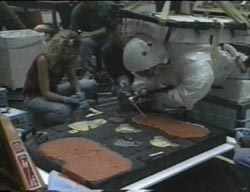 |
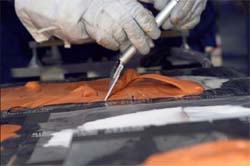 |
We are also examining many options to determine the most useful tools and appropriate processes for each damage level. We have tried rollers and brushes to smooth the filling material, or, not even using them but putting a transparent sheet into the hole to pour down the putty. We need to cooperate with EVA team staff in developing the repair process to test the various tools and methods in a weightless environment and verify that we can use them in space.
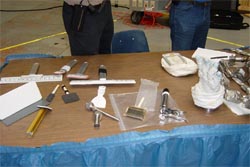 |
| Tools being tested for the TPS repair. Some of them were purchased in hardware stores. |
Moreover, we need to find a device that enables a good foothold on the Shuttle for holding on in space. One option is to get on an edge of the robotic arm, and there needs to be a strong partnership between the EVA crew member and the crew member who manipulates the robotic arm.
You can see it's a big challenge. Even though it looks easy to repair things on Earth, we need to see space repair from various perspectives.
 On-orbit
Inspection
On-orbit
Inspection
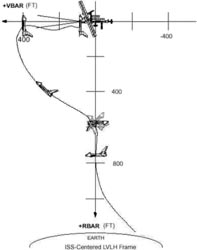 |
| Space Shuttle docking with the ISS. The Shuttle will make a three-sixty and be inspected 600 feet away from the ISS. |
The development of On-orbit Shuttle inspection is as important as the development of TPS repair methods. There are two potential techniques under consideration. One is to attach a camera and a laser sensor on the edge of the Shuttle's robotic arm boom to inspect the entire vehicle. The other is to rotate the Shuttle in order to see every side of the vehicle before docking so that we can take pictures of the tiles from the ISS. The pictures will then be sent to the ground for damage inspection. We call this maneuver a "Rendezvous Pitch Maneuver." I have been receiving training for this maneuver with other STS-114 members. The picture on the right shows the training using a Space Shuttle Rendezvous-Docking Simulator or a Space Shuttle Engineering Simulator Dome, the mockup of the Shuttle's flight deck. By projecting the actual view seen from the flight deck during the spaceflight, it feels as if you are in orbit, manipulating the Shuttle.
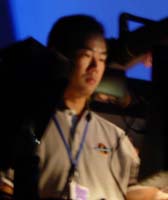 |
| Receiving training on the Space Shuttle Rendezvous-Docking Simulator. I support the commander and the pilot by giving them important information such as the Shuttle's position and attitude. |
In the Rendezvous Pitch Maneuver, we control the Shuttle to make a three-sixty at a point 600 feet away from the ISS. We slowly lift the nose at the rate of one degree per second from where we first see the ISS until we finally see the Earth. In the Rendezvous Pitch Maneuver, the commander and the pilot take charge of the controls and Astronaut Robinson and I assist them. Although it's a difficult maneuver, it's not a new technique, so I'm sure we can do it successfully on orbit by working together and repeated training.
The recommendations in the CAIB report clearly showed us what to do in the days to come. Following those recommendations, NASA made the Implementation Plan that specifically indicated our goals.
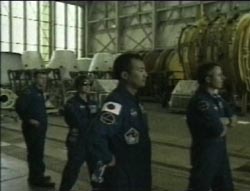 |
| LF1 crew |
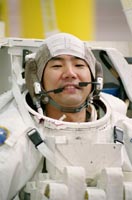 |
Since I became a member of the first flight team after the accident, I certainly feel some pressure. However I'm thankful at the same time to be assigned to take part in such a challenging mission aiming for the Shuttle's safer flight. As the launch schedule becomes clearer, we will certainly become more enthusiastic about accomplishing the mission. I'd like to continue my efforts to achieve the Shuttle's successful return to fight, resume the ISS assembly, and contribute to future human space flights.
